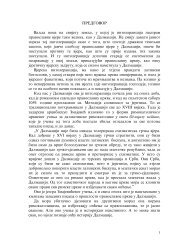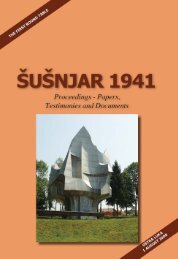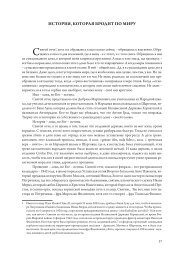Српске жртве Сребренице 1992-1995 - Srebrenica historical project
Српске жртве Сребренице 1992-1995 - Srebrenica historical project
Српске жртве Сребренице 1992-1995 - Srebrenica historical project
Create successful ePaper yourself
Turn your PDF publications into a flip-book with our unique Google optimized e-Paper software.
227context of the systematic military attacks those forces conducted from within theenclave of <strong>Srebrenica</strong>. For a part of that period (April 1993 — July <strong>1995</strong>) by mutualagreement reached under UN auspices those forces should have been demilitarised,but as a result of international community’s unwillingness to assertitself that agreement was never implemented. Furthermore, according to the Reporton <strong>Srebrenica</strong> published in 2002 by the Dutch Institute for War Documentation(NIOD), as a result of those attacks about 8,500 Serbian inhabitants of<strong>Srebrenica</strong> region were forcibly expelled. 21 These are not insignificant statistics.On the political level, throughout the period of these attacks the internationalcommunity had forces on the ground, such as UNPROFOR, as well asother instruments, sufficient to make it aware of what was happening and adequateto formulate an effective humanitarian response to restrain the attackers. Itfailed to do so. That failure to act strongly suggests that political considerationsdictated a critical attitude toward the conduct of one side and, parallel to that, anattitude of benign neglect toward the conduct of the other.Finally, on the legal level, if criteria that are used for the standard analysisof events of July <strong>1995</strong> were applied to the factual matrix of this monograph, astrong prima facie argument could be put forward that if the execution of ABiHprisoners of war in <strong>1995</strong> qualifies as genocide, the systematic and targeted destructionof the <strong>Srebrenica</strong> Serbian community during the three preceding yearsqualifies for the identical classification.The present monograph is an introduction to an almost totally overlookeddimension of “<strong>Srebrenica</strong>”: massive casualties and destruction suffered by thelocal Serbian population. Much additional research into the subject needs to bedone. However, even these incomplete data strongly suggest that the dimensionsof “<strong>Srebrenica</strong>” are much broader than the narrow scope of the institutionalisednarrative on that subject would convey. <strong>Srebrenica</strong> is not a mono-ethnic narrative,but a human tragedy of major proportions which affected all inhabitants ofthat region of Bosnia and Herzegovina, irrespective of their ethnicity or religion.21 NIOD Report, Part I: The Yugoslavian problem and the role of the West, 1991–1994;Chapter 10: <strong>Srebrenica</strong> under siege.
















